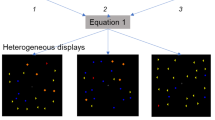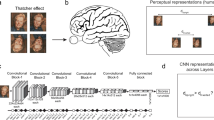Abstract
Do we recognize common objects by parts, or as wholes? Holistic recognition would be efficient, yet people detect a grating of light and dark stripes by parts. Thus efficiency falls as the number of stripes increases, in inverse proportion, as explained by probability summation among independent feature detectors1. It is inefficient to detect correlated components independently. But gratings are uncommon artificial stimuli that may fail to tap the full power of visual object recognition. Familiar objects become special as people become expert at judging them2,3, possibly because the processing becomes more holistic. Letters and words were designed to be easily recognized, and, through a lifetime of reading, our visual system presumably has adapted to do this as well as it possibly can. Here we show that in identifying familiar English words, even the five most common three-letter words, observers have the handicap predicted by recognition by parts: a word is unreadable unless its letters are separately identifiable. Efficiency is inversely proportional to word length, independent of how many possible words (5, 26 or thousands) the test word is drawn from. Human performance never exceeds that attainable by strictly letter- or feature-based models. Thus, everything seen is a pattern of features. Despite our virtuosity at recognizing patterns and our expertise from reading a billion letters, we never learn to see a word as a feature; our efficiency is limited by the bottleneck of having to rigorously and independently detect simple features.
This is a preview of subscription content, access via your institution
Access options
Subscribe to this journal
Receive 51 print issues and online access
$199.00 per year
only $3.90 per issue
Buy this article
- Purchase on Springer Link
- Instant access to full article PDF
Prices may be subject to local taxes which are calculated during checkout




Similar content being viewed by others
References
Robson, J. G. & Graham, N. Probability summation and regional variation in contrast sensitivity across the visual field. Vision Res. 21, 409–418 (1981)
Diamond, R. & Carey, S. Why faces are and are not special: an effect of expertise. J. Exp. Psychol. Gen. 115, 107–117 (1986)
Gauthier, I., Skudlarski, P., Gore, J. C. & Anderson, A. W. Expertise for cars and birds recruits brain areas involved in face recognition. Nature Neurosci. 3, 191–197 (2000)
Treisman, A. & Schmidt, H. Illusory conjunctions in the perception of objects. Cogn. Psychol. 14, 107–141 (1982)
Biederman, I. Recognition-by-components: a theory of human image understanding. Psychol. Rev. 94, 115–147 (1987)
Tarr, M. J. & Buelthoff, H. H. Image-based object recognition in man, monkey and machine. Cognition 67, 1–20 (1998)
Pelli, D. G., Palomares, M. & Majaj, N. J. Crowding is unlike ordinary masking: distinguishing feature detection and integration. J. Vision [online] 〈http://www.journalofvision.org/〉 (in the press)
Cattell, J. M. The time taken up by cerebral operations. Mind 11, 220–242 (1886)
Huey, E. B. The Psychology and Pedagogy of Reading (Macmillan, New York, 1908)
Reicher, G. M. Perceptual recognition as a function of the meaningfulness of stimulus material. J. Exp. Psychol. 81, 275–280 (1969)
Wheeler, D. D. Processes in word recognition. Cogn. Psychol. 1, 59–85 (1970)
Johnston, J. C. & McClelland, J. L. Perception of letters in words: seek not and ye shall find. Science 184, 1192–1194 (1974)
Johnston, J. C. & McClelland, J. L. Experimental tests of a hierarchical model of word identification. J. Verbal Learn. Verbal Behav. 19, 503–524 (1980)
McClelland, J. L. & Rumelhart, D. E. An interactive activation model of context effects in letter perception: Part 1. An account of basic findings. Psychol. Rev. 88, 375–407 (1981)
Prinzmetal, W. & Silvers, B. The word without the tachistoscope. Percept. Psychophys. 55, 296–312 (1994)
Jordan, T. R. & Bevan, K. M. Position-specific masking and the word–letter phenomenon: reexamining the evidence from the Reicher-Wheeler paradigm. J. Exp. Psychol. Hum. Percept. Perform. 22, 1416–1433 (1996)
Peterson, W. W., Birdsall, T. G. & Fox, W. C. Theory of signal detectability. IRE Trans. Inf. Theory 4, 171–212 (1954)
Pelli, D. G. & Farell, B. Why use noise? J. Opt. Soc. Am. A 16, 647–653 (1999)
Tanner, W. P. Jr & Birdsall, T. G. Definitions of d′ and η as psychophysical measures. J. Acoust. Soc. Am. 30, 922–928 (1958)
Legge, G. E., Pelli, D. G., Rubin, G. S. & Schleske, M. M. Psychophysics of reading—I. Normal vision. Vision Res. 25, 239–252 (1985)
Pelli, D. G., Burns, C. W., Farell, B. & Moore, D. C. Identifying letters. Vision Res. (in the press)
Campbell, F. W. & Robson, J. G. Application of Fourier analysis to the visibility of gratings. J. Physiol. (Lond.) 197, 551–566 (1968)
Watson, A. B. & Robson, J. G. Discrimination at threshold: labelled detectors in human vision. Vision Res. 21, 1115–1122 (1981)
Kucera, H. & Francis, W. N. Computational Analysis of Present-Day American English (Brown Univ. Press, Providence, 1967)
Hadley, J. A. & Healy, A. F. When are reading units larger than the letter? Refinement of the Unitization Reading Model. J. Exp. Psychol. Learn. Mem. Cogn. 17, 1062–1073 (1991)
Barlow, H. B. Summation and inhibition in the frog's retina. J. Physiol. (Lond.) 119, 69–88 (1953)
Solomon, J. A. & Pelli, D. G. The visual filter mediating letter identification. Nature 369, 395–397 (1994)
Majaj, N. J., Liang, Y. X., Martelli, M., Berger, T. D. & Pelli, D. G. The channel for reading. J. Vision [online] 3 〈http://www.journalofvision.org/〉 (2003)
Selfridge, O. Pandemonium: a paradigm for learning. Symposium on the Mechanization of Thought Processes 513–526 (HM Stationery Office, London, 1959)
Johnston, J. C. A test of the sophisticated guessing theory of word perception. Cogn. Psychol. 10, 123–153 (1978)
Acknowledgements
Thanks to our many friends and colleagues who provided helpful comments, especially W. S. Geisler and R. F. Murray, who suggested that psychometric steepness may help to explain the reciprocal relation between efficiency and word length, J. M. Radner, who helped us say what we meant, I. Gauthier, D. J. Heeger, J. C. Johnston, M. S. Landy, G. E. Legge, J. M. Loomis, G. L. Murphy, R. E. Nixon, W. P. Prinzmetal and E. E. Smith. This work was supported by National Eye Institute grants to D.G.P. and B.F. D.C.M. was a Syracuse University undergraduate when she ran these experiments.
Author information
Authors and Affiliations
Corresponding author
Ethics declarations
Competing interests
The authors declare that they have no competing financial interests.
Supplementary information
Rights and permissions
About this article
Cite this article
Pelli, D., Farell, B. & Moore, D. The remarkable inefficiency of word recognition. Nature 423, 752–756 (2003). https://doi.org/10.1038/nature01516
Received:
Accepted:
Issue Date:
DOI: https://doi.org/10.1038/nature01516
This article is cited by
-
Faces, English words and Chinese characters: a study of dual-task interference in mono-and bilingual speakers
Experimental Brain Research (2023)
-
Spatial attention in encoding letter combinations
Scientific Reports (2021)
-
Oscillatory visual mechanisms revealed by random temporal sampling
Scientific Reports (2021)
-
Multiple routes to word recognition: evidence from event-related potentials
Psychological Research (2021)
-
Dynamic Perception of Well-Learned Perceptual Objects
Computational Brain & Behavior (2021)
Comments
By submitting a comment you agree to abide by our Terms and Community Guidelines. If you find something abusive or that does not comply with our terms or guidelines please flag it as inappropriate.



